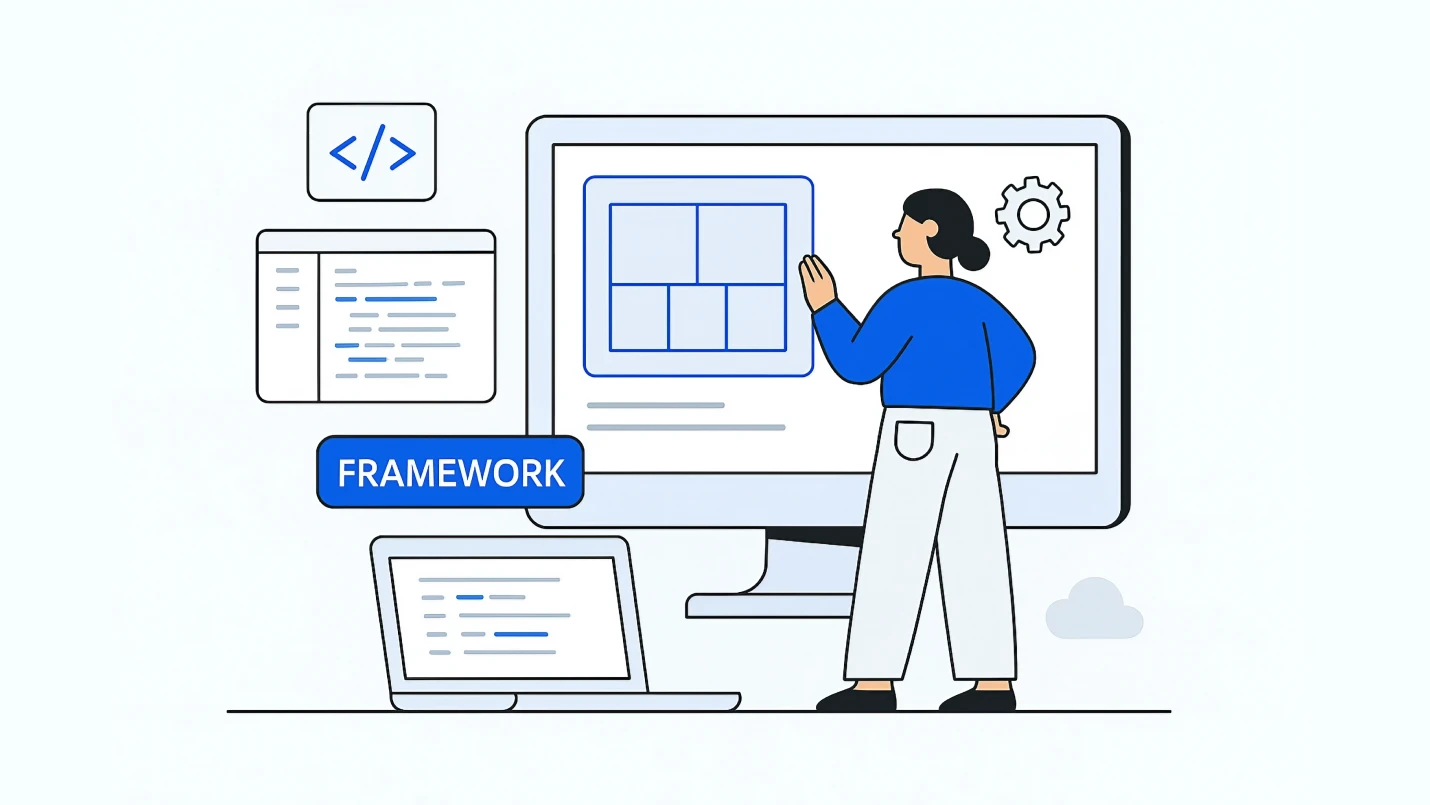Coding can be challenging, even for those with an IT background. Development must go through various tasks, debugging frustrations, and trial and error. Many successful teams prefer using frameworks to reduce development time. These frameworks feature libraries of APIs, software modeling, and bundled code to make programming easier.
Let’s explore what programming frameworks are, why they matter, and what features should a programming framework ideally include:
What is a Framework in Programming?
The dictionary definition of the framework as a “basic structure underlying a system” is not far different from what a framework is in programming. Whether the system is a house, a car, a theory, or a mobile app, the concept of the framework is the same: it provides the support and essential ‘guide’ of the structure being built.
A framework in programming is a tool that provides ready-made components or solutions that are customized to speed up development. A framework may include a library but is defined by the principle of inversion of control (IoC). With traditional programming, the custom code calls into the library to access reusable code. With IoC, the framework calls on custom pieces of code when necessary.
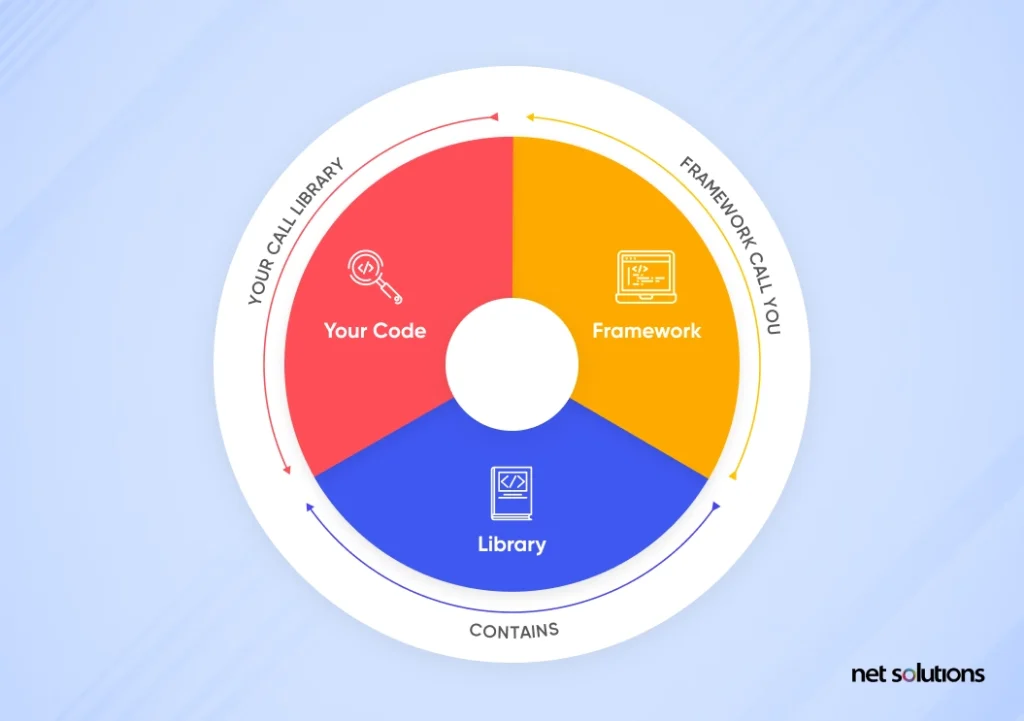
A framework can include support programs, compilers, code libraries, toolsets, and APIs to develop software and create systems. Open-source frameworks are constantly being updated and improved.
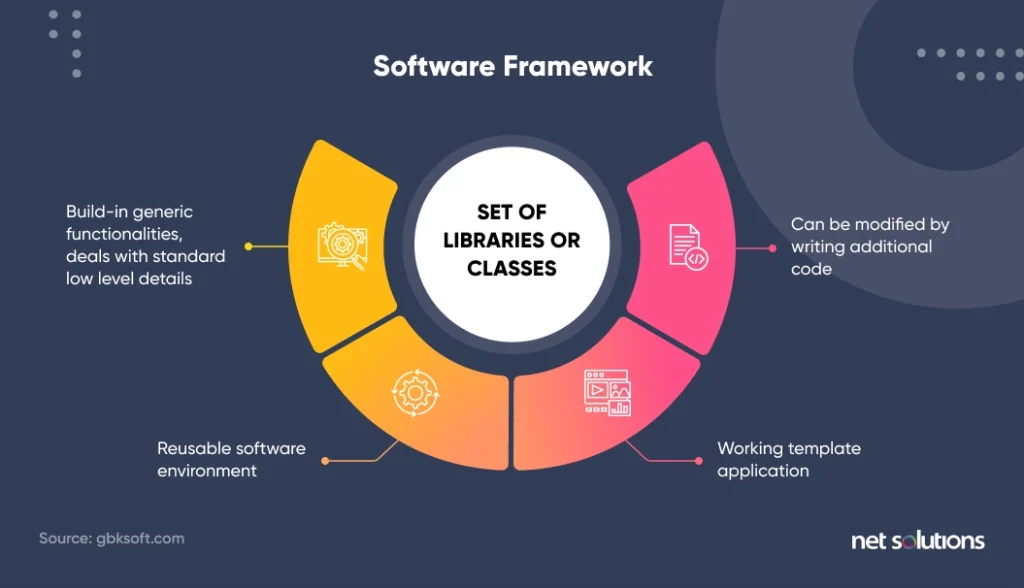
Why are Frameworks Used in Software Development?
The purpose of a framework is to assist in the development, providing standard, low-level functionality so that developers can focus efforts on the elements that make the project unique.
High-quality, pre-vetted functionality increases software reliability, speeds up programming time, and simplifies testing. With an active base of users and ongoing code improvements, frameworks help improve security and offer a base of support.
Ultimately, frameworks are used to save time and money.
What are the Features of a Good Framework?
There are many kinds of frameworks, with some more popular than others. Developers often choose frameworks they are most familiar with, but that framework may not be the right for the job. Instead, consider the following features of good frameworks when deciding on the proper framework for the project at hand:
- Functionality: Choose a framework that provides the functionality needed for the project at hand, respecting that each framework has its limits and not investing in a framework that does far more than your project will ever need.
- Consistency: A framework that can assist in consistency for large or distributed teams
- Documentation: Choose a framework that has well-documented code and provides implementation training
- Active Community: Frameworks are only as robust as the user base of support. Choose a framework that is well-established with an active user base.
Challenges of Using a Software Framework
Software frameworks can become a costly crutch if developers are not strong in the language the framework is based upon or if the developer over-relies on the framework instead of custom code. This problem can lead to software bloat and performance issues.
There are risks in choosing a framework that is too new or unsupported, which could require costly re-tooling if the framework becomes obsolete. Similarly, if the framework has poorly understood limitations, this could impact the project.
Types of Programming Frameworks
There are various programming frameworks, each built upon a programming language and specializing in its function, whether working on a web app, database, or mobile app. This section will include various programming frameworks, popular frameworks for each type, and everyday examples.
1. Web Frameworks
Web application frameworks (WAF), or web frameworks (WF), support the development of web applications with web services, web resources, and web APIs. There are different web frameworks for both the front end (how the web app looks) and the back end (how it works).
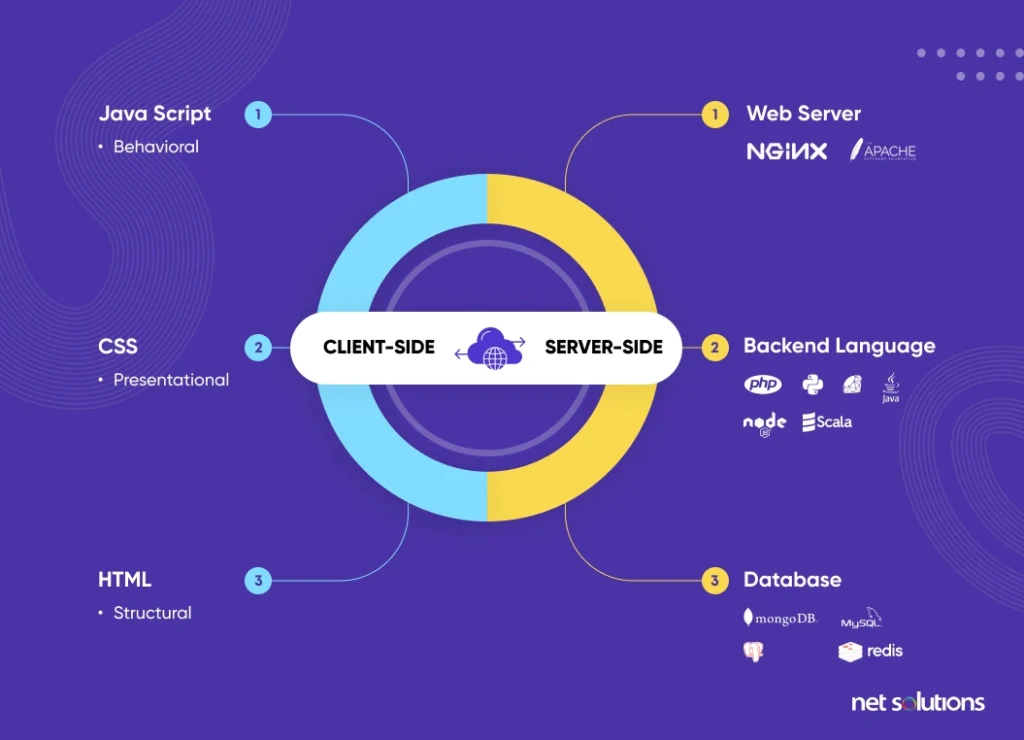
A. Front-End Frameworks
Front-end (client-side) frameworks provide basic templates and HTML, CSS, and JavaScript components for building a website or web app’s front end.
i. Angular
What is Angular? Angular is an open-source web application framework based on TypeScript and maintained by the Angular Team at Google. Angular features a large ecosystem of tools and solutions from a broad user base. Angular is ideally suited for highly customized and progressive web apps (PWAs).
AngularJS refers to all 1.X versions of the framework that previously were JavaScript-based, with Angular being a complete rewrite using TypeScript for all versions 2 and up. Over 1.4 million live websites are using Angular.
Angular Framework Examples: PayPal, Upwork, Google, Nike
ii. Vue JS
What is Vue JS? Vue JS (Vue.js) is a JavaScript-based progressive framework that offers greater flexibility around using HTML and CSS and the model-view-view model (MVVM) architecture. Vue is easy to learn and has a vast community of support.
Vue JS Framework Examples: Trustpilot, Nintendo, Behance
B. Back-End Frameworks
Backend (server-side) frameworks provide generic functionalities that can be assembled or built upon to assist development. The choice in the framework will be dictated by the programming language chosen for growth and the target platform(s).
i. Ruby on Rails
Ruby on Rails is an open-source framework written with the Ruby language. Ruby runs on Linux based on the model-view-controller (MVC) architecture. Ruby is secure and scalable and benefits from large third-party libraries to speed up development.
Nearly 17% of the top 10k websites leverage Ruby on Rails.
Ruby on Rails Framework Examples: Airbnb, Kickstarter, BaseCamp, CafePress
ii. PHP Frameworks (Laravel, CodeIgniter, CakePHP)
What are PHP Frameworks? PHP runs on diverse platforms and is widely compatible, making it popular as a language for back-end development. The most popular PHP frameworks are Laravel, CodeIgniter, and CakePHP.
Laravel features are expressive and elegant syntax, helping make coding faster and leveraging a powerful Blade template engine. CodeIgniter offers a light framework with one of the smallest footprints, saving time with less coding needed. CakePHP is considered the “workhouse” of the three; leveraging a scaffolding system and deferring to convention over configuration saves development time.
PHP Framework Examples: MyRank (Laravel), Casio (CodeIgniter), Nissan (CodeIgniter), 10FastFingers (CakePHP)
iii. Django
Django is an open-source framework for Python that encourages rapid, scalable development and clean design. Django aims to provide everything you need, making it easy to piece your needs. Django is popular for visual effects, games, and interactive services.
Django Framework Examples: Disqus, Instagram, Spotify, YouTube
iv. ASP.NET and ASP.NET Core
What is ASP.NET? ASP.NET is a cross-platform open-source framework developed by Microsoft, with ASP.NET Core a re-implementation as a modular web framework. ASP.net supports web apps and services with .NET, C#, F#, and Visual Basic programming languages.
ASP.Net Framework Examples: Microsoft, StackOverflow, GoDaddy
2. Mobile App Development Frameworks
A mobile development framework (mobile app development framework) supports the development of mobile applications for a specific environment, classified as native (platform-specific), hybrid (native back-end shell with web app front-end), or cross-platform (shared codebase for all). There are many mobile app development frameworks not covered here, including, among many, Swiftic, Native Scripts, and Ionic.
A. React Native
What is React Native? React Native is an open-source JavaScript UI framework created by Facebook to develop Android and iOS applications. It targets mobile platforms instead of the browser.
React Native Framework Examples: Facebook, Skype, Shopify, and NFL use ReactNative for their Android and iOS applications.
B. Flutter
What is Flutter? Flutter is Google’s open-source mobile UI framework for creating cross-platform applications and, most recently, with Flutter 2, web, and desktop (native) apps. Flutter is based upon Dart and is considered a modern framework, being simple to use and leveraging hot reload to see results in real-time.
Flutter Framework Examples: Amazon, Microsoft, Adobe, eBay, Google ads
C. Xamarin
What is Xamarin? Xamarin is an open-source framework using C# and .NET for creating apps owned by Microsoft. Xamarin is a cross-platform framework that allows you to reuse a shared codebase. With Xamarin, UI components convert into platform-specific elements at runtime, allowing a more native experience for iOS, Android, and Windows.
Xamarin Framework Examples: Alaska Airlines, Microsoft Azure, Outback, BBC Goodfood
D. Ionic
What is Ionic? Ionic is an open-source, cross-platform mobile app development framework. Developers can build mobile apps on Android, iOS, and web platforms.
Ionic Framework Examples: JustWatch, MarketWatch, and Untapped.
E. Apache Cordova
What is Apache Cordova? Formerly known as PhoneGap, Apache Cordova is an open-source framework for building mobile apps using JavaScript, HTML, and CSS. It acts as a bridge between web technologies and native device features. Hence, using this framework, you can build apps that seamlessly run across multiple platforms while offering native device features like contacts, file systems, cameras, etc.
Apache Cordova Framework Examples: HealthTap and Trello.
3. Content Management Frameworks
A Content Management System (CMS) enables users to build, organize, deliver, and modify content, including blog posts, eBooks, mobile apps, or other online solutions. A content management framework (CMF), sometimes referred to as a CMS platform, is a tool that supplies reusable components for managing web content and sharing aspects of a web app framework and a CMS.
Decisions around CMS frameworks extend beyond simply pricing, language, or ease of use to important considerations around SEO, personalization, and security.
A. WordPress
What is WordPress? WordPress is the leading free, open-source CMS platform, used by over 42% of all websites.
WordPress is very user-friendly, making it ideal for the non-technical user developing a small blog or for more prominent brands supporting everything from microsites to large eCommerce stores. Many plug-ins, themes, and extensions create a backbone for a personalized, flexible site that has the potential to be sure – as long as you choose vetted, regularly updated plugins.
WordPress Framework Examples: Sony Music, Angry Birds, TechCrunch, The New Yorker, BBC America.
B. Drupal
What is Drupal? Drupal is a free, open-sourced modular CMS written in PHP and supported by a large community. Drupal does, however, require more technical knowledge than some other frameworks.
Drupal is known for its flexible taxonomy, making it ideally suited for projects with a lot of content and/or many community features and large webmaster teams.
Drupal Framework Examples: Arsenal FC, InStyle, Mattel, Tesla, Warner Bros. Records
C. Joomla
What is Joomla? Joomla is a free open-sourced CMS that, like Drupal and WordPress, is easy to customize with templates and extensions. Joomla is easier to use than Drupal for the non-technical but more complex than WordPress. Joomla is the third most popular CMS platform, SEO-optimized out of the box, and has an excellent security track record.
Joomla Framework Examples: IKEA, LINUX, Holiday Inn, Harvard University
D. Kentico
What is Kentico? Kentico is a commercial framework/platform built in ASP.NET and Microsoft SQL Server, offering faster implementation with more ready-made options. Kentico leverages simple page-building and editing tools.
Kentico Framework Examples: Skype.com, NewsMax, Swagger.io, Gibson, First American Bank
4. Data Science Frameworks
Data science is a broad field related to applying statistics, scientific methods, algorithms, or systems to extract knowledge from data. Today, data science is a booming area of interest, partly driven by artificial intelligence and machine learning opportunities.
While the vast majority of data science involves Python, there is a growing use of data science frameworks, including TensorFlow, PyTorch, Apache Spark, and NumPy. This guide will explore them all:
A. TensorFlow
What is TensorFlow? TensorFlow is an open-source machine learning (ML) platform developed by Google based on deep-learning neural networks. TensorFlow provides an open-source library and tools to build and deploy ML-powered apps. On-device deep learning takes the form of speech recognition, image recognition, gesture recognition, object localization, translation, optical character recognition, voice synthesis, and text classification.
Tensorflow Framework Examples: Google Translate, FaceNet, Mozilla’s Deep Speech, Google RankBrain
B. PyTorch
What is PyTorch? PyTorch is an open-source machine learning framework for developing deep learning models. The framework is primarily used in AI as it offers a flexible approach to building neural networks.
PyTorch framework examples: Image classification, object detection, and natural language processing.
C. Apache Spark
What is Apache Spark? Apache Spark is an open-source framework for big data analytics and processing. It supports many programming languages, such as Java, Scala, Python, and R, making it an accessible option for many developers and data scientists.
Apache Spark Framework Examples: Large-scale data processing and analytics, real-time stream processing, machine learning, predictive analytics, real-time stream processing, and data streaming.
Common Misconceptions About Programming Frameworks
There may be lingering misconceptions or confusion about programming frameworks, including
Framework vs. Programming Language
Most of us confuse a framework and a programming language as both are used to develop software. However, both are two different concepts.
The best way to distinguish between a framework and a programming language is by a purpose: A language can help you build many things, but a programming framework is purpose-built for one purpose only – whether a web app, mobile app, CMS, or data science.
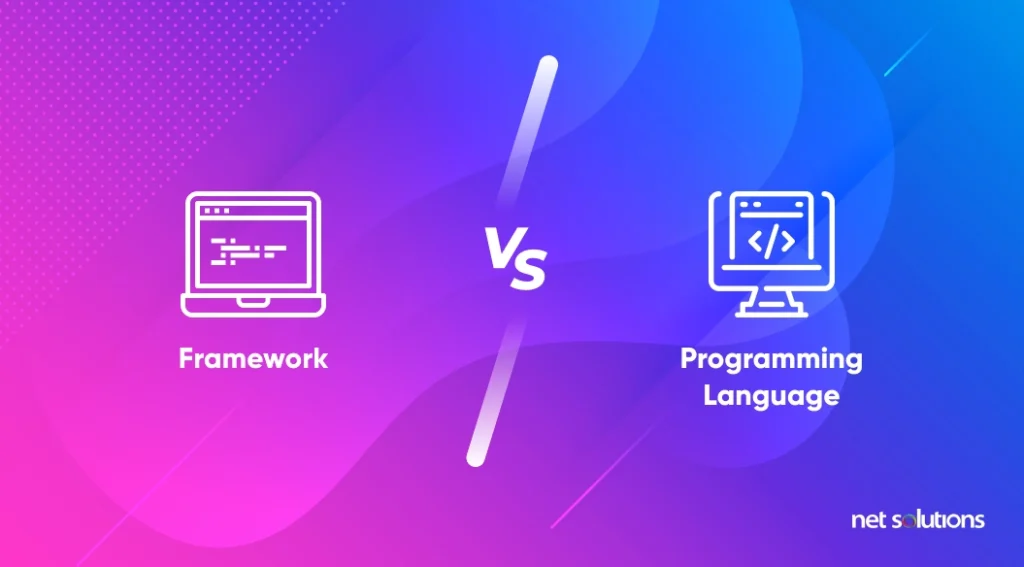
Also, a programming language is the foundation for each programming framework: the instructions defining the framework on what to do. The framework is the platform to help you develop software. Moreover, you do not have to use a framework to build software; all software is developed with a programming language(s).
Framework vs. Library
It is common to need clarification on the term framework and library, as both are tools used within programming. As described above in the section “What is a Framework?” a library is just one tool available within a framework.
A framework is your structure or environment to build your software: it contains access to various tools, including libraries, to assist in your build.
A library is a set of low-level components that can be invoked (called) for a specific outcome. You can access a library directly, called from the code, or a framework can supply access to libraries and call out to the code (inversion of control).
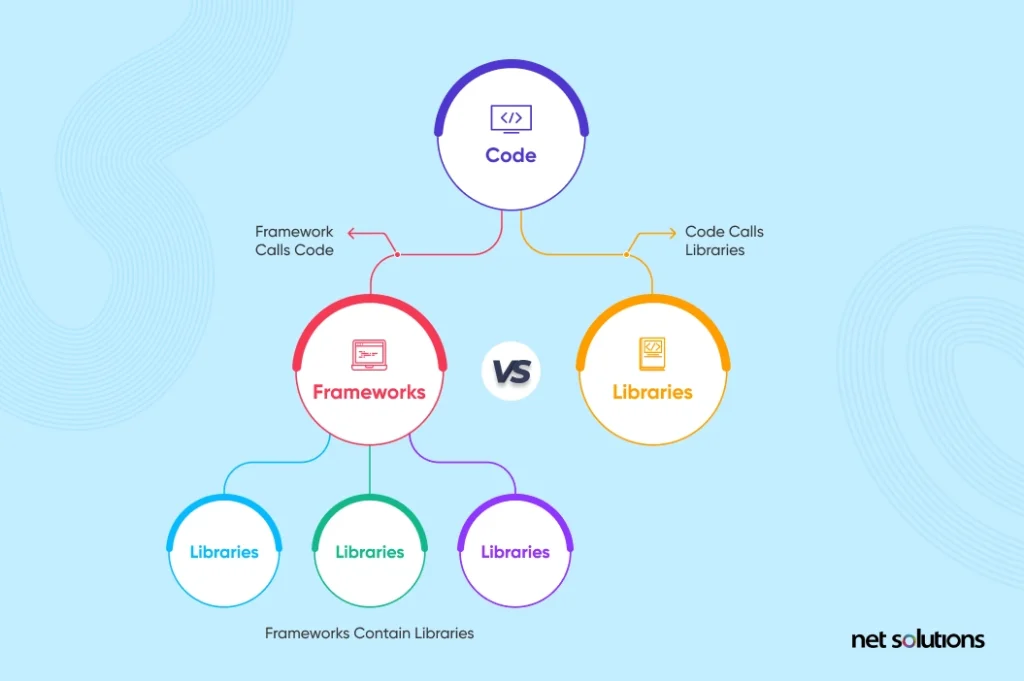
How Can Net Solutions Help You Build a High-quality Software with the Right Programming Framework?
Whether you’re a mobile app development company or a cross-platform app development services provider – programming frameworks provide a starting point to solve common problems, integrate programming best practices, and stay on top of the latest technology options.
In short, the right frameworks can speed up your time to market and propel your growth strategy. But how do you know which programming frameworks are right for you? Or how to combine frameworks across all your needs?
At Net Solutions, we work closely with you to set priorities and ensure the frameworks, wireframes, architecture, and prototypes produce the maximum impact for your brand or business.
Frequently Asked Questions
Node.js is not a framework but a JavaScript runtime environment allowing developers to run JavaScript code on the server side. Although, you can use Node.js with frameworks and libraries for building server-side applications.
Django, Flask, Pyramid, FastAPI, CherryPy, and Bottle are popular Python frameworks.
While many frameworks like Hibernate, Apache Struts, Play Framework, and JavaServer Faces (JSF) are also available, Spring is one of the most popular frameworks in Java.
Yes, Spring Boot is a framework for building Java applications specifically designed to simplify the development of Java-based enterprise applications.

